#bulgar wheat
Text

Chorizo Style Carrots With Tabbouleh
#savoury#lunch#dinner#avantgardevegan#carrot#carrots#cous cous#bulgar#bulgar wheat#tahini#chickpeas#chickpea#mint#parsley#recipe#recipes#food#levantine#syrian#glutenfree#gluten free
16 notes
·
View notes
Text
as an old faggot whore, I remember very well how you behave next -
pretending for a while that your "perspective" is "nuanced"
pretending for a while that you mean something else entirely, something that's common sense and yet somehow inexpressible in mere words, "bad people are bad" with a thumb-sucking puppy dog gaze, the silent "I am not a bigot 😭"
later pretending you never held these views. Waiting long enough to say how shocked, shocked you were when others expressed them. Anecdotes about how you were so wise, so good -
I was the same, for decades, the same as you, with one exception: I addressed it because I heard words coming out of me that were the same words used against me, by your dad. WHILE I was letting him fuck me for money.
I'm not saying you're worthless or that your minds are useless (verbatim what some of you have been saying about me today! thanks! so eye-opening!), I'm saying you're on a bad trip and you could get off it if you had any courage. So far, you don't.
Some of you will tell me in private that you agree. Say it loud and public. Or just go stand with the ones you are truly in solidarity with and quit pretending. I could have stood up long ago. I should have. I should have shouted your ugly ass dad down immediately, but I didn't, and now you are just like him.
#and still I haven't told you to kys or wished that you would die#guess I'm brainwashed by the hippies and their damned bulgar wheat soup
7 notes
·
View notes
Text
What is a Plant-Based diet?
This blog is about my journey and experiences cooking and eating healthy food with my family.
I’m a passionate cook and I aim to take the mystery out of what a plant based diet means. If you are interested I'd like to show you how to do it too.
The Plant Based diet is made up of a variety of grains such as oats, barley, quinoa, bulgar wheat, buckwheat, and rice, legumes such as peas, beans, and lentils, vegetables, fruit, dairy-free versions of milk, cheese and yoghurt, pasta, bread, nuts, seeds and much more.
I would also like to mention the benefits I have experienced are a noticeable increase in energy levels and all round well-being since committing to eating this way. *Please enter a little disclaimer here about how I can't promise everyone will feel this way.
We simply need to know what to look out for and where, plan ahead and ensure we are reaching our nutritional needs. This goes for any food based plan we follow. It doesn't take long to source all your favourite ingredients based on price, availability and personal choices. We are creatures of habit and usually settle on a series of dishes we enjoy that may vary throughout the seasons. I think of soups and stews more in the winter and lighter meals in the summer. It would be interesting for you to take a look in your kitchen cupboards and fridge right now to see what kind of variety you are currently eating.
The foods that I choose not to consume are ones that are made from or contain animal products. The "why" is not very important here as I feel everyone will have their own personal reasons for not consuming animal products. I focus on what we can eat instead of what we cannot.
#family#plant based#vegan#veganism#what vegans eat#healthy#energy#variety#meals#dairy free#lactose free#choice#understanding#plans
6 notes
·
View notes
Note
what's your diet like? what do you eat?
I eat lots of fruit, veg and pulses (favourites: apples, apricots, cherries, pears, satsumas, bananas, grapes, mangos, pomegranates, avocados, carrots, peppers, chillies, broccoli, cauliflower, aubergine, cabbage, brussel sprouts, kale, green beans, sweet potatoes, artichoke, asparagus, sweetcorn, peas, lentils, chickpeas, kidney beans, black beans, etc) and whole grains (oats, barley, bulgar wheat, wild rice, quinoa). I like potatoes, pasta and noodles. I eat lots of nuts (almonds, hazelnuts, walnuts, pistachios, pecans) and dried fruit (dried mango, cranberries, sultanas). I like pickled food (sundried tomatoes, pickled chillies, gherkins, capers, olives) and fermented food (kimchi, sauerkraut, miso, yoghurt). I eat lots of sourdough bread and need to start making my own!
I eat seafood (salmon, anchovies, trout, prawns) and meat (chicken thighs, lamb, pork chops). I try to avoid beef. I also try not to eat beef that often. I eat lots of eggs, and I like cheese (feta is probably my favourite, or goat's cheese). I use lots of vinegars (red wine, white wine, cider, balsamic) and lemon/lime juice in cooking. I want to get better at cooking tofu. I eat lots of honey (local).
I also drink lots of water and I like coffee, green tea, mint tea and green juice. I also like wine, and tequila. I take various supplements (calcium and vitamin d; a multivitamin; cod liver oil; iron; magnesium; q10).
I try to only drink alcohol twice a week, am working on getting more sleep, and also doing pilates to strengthen my joints. I have created a standing desk too so that I sit down less. when I brush my teeth I stand on one leg and then the other.
this year I am aiming to get my 10k run time to under an hour and also to be able to do crow pose in yoga, and to start swimming again.
#personal#food#diet#i spend lots of time and effort on being as healthy as possible#i find it soothing to do this and to think about it even#i lift weights and can lift more than my body weight now. but still cannot do a press up?#i also do intermittent fasting sometimes#idk. it is fine.#anon#ask
2 notes
·
View notes
Text
Wed 16th Nov '22

Oh my God, oh my God, oh my God! I just booked a hotel and flight for Manchester! My heart is properly in my mouth now. I've got serious butterflies. WHAT THE ACTUAL FUCK? Damn, I'm almost hyper ventilating. TGG is a calming influence and very sensibly told me I've ages and have nothing to panic about, but I'm still a bit weirded out.
I checked out the course map, but it's not nailed down yet. Last year's map shows the start and finish quite close together, making it a large loop. I booked a hotel about half a mile from last year's finish. There is free cancellation so if the course changes significantly, I can change my booking.
I can't change the flight. Eek! It's sort of locked in. Right. I'm gonna not panic now. Shit!!!
I ended up making a big mug of camomile tea last night, to stave of the hunger after dinner. I did get very close to eating a punnet of grapes, which wouldn't have been the worst decision, but it was about 240 cals that I didn't really need, and without them I stayed on target. I'm pleased with that, even if it does make me out to be a tad obsessive.
I ran early this morning. I had an appointment to get my next covid vaccination and flu one early today. I didn't know if it would affect me badly, so I thought the best thing was to get the run done. I need to get used to doing these runs regardless of how I feel.
It was raining today. I ran to the park and just ran continuously up and down the shallow hill at the sides of the tennis courts. There was a massive puddle at one end. It was fun to run through that fourteen times 💦 I did the L shape those fourteen times in thirty minutes. It was slow, but steady. It wasn't particularly unpleasant. Damned with faint praise, or what! That was in lieu of a club session, as I didn't go tonight. I think Coach will be happy enough as it was a slow 5k that had steady, low gradient hills.

A visit to Mum after the vaccinations where she fed and watered me. It was not too healthy, for all it was vegan friendly. It was early in the day, so I had very healthy bulgar wheat and edamame beans with nutritional yeast for dinner risotto type thing. Very similar to a couple of nights ago, with added spinach and asparagus and edamame instead of broad beans. Delish! Reckon I'm 600 cals over for the day. And yet I still feel good.
Aims for tomorrow are a rest from running and a proper wholefood day!
2 notes
·
View notes
Note
What are some of the recipes you’ve ‘invented’ based on S.F.A.H?
Honestly I mainly use the 'Salt, Fat, Acid, Heat' schema to improv based on what's in the fridge or tweak recipes that disappoint me -- there's not that many repeat, consistent recipes I've made totally from scratch.
One that probably counts is our SE Asian style curry (tom yum paste + Malaysian sambal + coconut milk + stock + whatever protein and veg we have sitting around) which, because it's also at least half improv, always needs tweaking (lime! fish sauce! chilli oil!). I've also 'invented' a spin on that viral feta + tomato pasta from a few years back but mine is Greek style lamb meatballs (these were based on a real recipe I found online but amended) seared and then roasted with tomatoes, feta, lemon, garlic, and fresh oregano, served with bulgar wheat. We also do a fair amount of green sauce based on this recipe -- it's whatever herbs are in the fridge and getting old + honey, white miso, ginger, vinegar, whatever citrus we have, salt. I count it because despite being a recipe, you can't just make it as written, it requires the balancing techniques from SFAH.
I use the SFAH idea pretty much every time I cook or eat something - recipes are more like guidelines really and you should always be tasting and amending as you go to suit your pallet and adjust for your exact ingredients. I've used the idea to fix my soup at a sub par restaurant (balsamic vin + salt brightened the whole thing up) and to make packet ramen even better. But generally it sits in the background of how I cook rather than me sitting down and inventing a new recipe based on the idea.
6 notes
·
View notes
Text

Dietary Recommendations for an Ileostomy
During ileostomy surgery, the entire colon, rectum, and anus are removed or bypassed. An ileostomy is placed by the surgeon through an opening in the abdominal wall. The end portion of the ileum (part of your small intestine) is brought through the abdominal wall, forming what is called the stoma.
The stoma must be covered with a bag at all times to collect stool. An ileostomy may be temporary or permanent depending on the surgery. After surgery, your eating plan will begin with clear liquids. As you recover, you will start eating small amounts of solid foods that are low in fiber. Most people begin to eat more normally 6 weeks after surgery.
General Food Recommendations
Foods to Include:
Low-Fiber Foods: Low-fiber foods are easier to digest. Although not the healthiest, white bread, white rice, and refined cereals are usually tolerated. Instead, I would recommend rye bread, sourdough, rice, or almond flour crackers.
Lean Proteins: Choose lean protein sources such as skinless poultry, fish, eggs, and well-cooked, tender meats.
Non-Dairy Substitutes: This includes nut milks and creamers, vegan cheeses, and spreads.
Fruits and Vegetables: Peel and cook vegetables and fruit to make them easier to digest. Vegetables are best roasted, sauteed, grilled, or steamed. Apples, pears, and peaches can be baked. Pulp-free fruit juices are generally okay. Tomato sauce and puree should also be okay.
Healthy Fats: Include sources of healthy fats such as olive oil, avocado and avocado oil, coconut oil, and nut butters.
Hydration: Stay well-hydrated by drinking at least 72 oz of water throughout the day.
Foods to Avoid:
High-Fiber Foods: Initially, avoid high-fiber foods like whole grains, nuts, seeds, and raw vegetables.
Gas-Producing Foods: Minimize intake of gas-producing foods like beans, cabbage, and carbonated beverages.
Spicy Foods: Limit or avoid spicy foods that may irritate the digestive system.
Certain Fruits and Vegetables: Limit or avoid high-fiber fruits and vegetables with skins or seeds.
Dairy: lactose can cause gas in the stoma and is generally not well tolerated. It's best to avoid all dairy.
Beverages: Avoid caffeinated coffee and tea, hot chocolate, carbonated beverages, soda and sugary beverages.
Fiber
Dietary fiber is present in all plant food in the form of soluble and insoluble fibers. After having an ileostomy, you should avoid foods rich in insoluble fiber (bran-enriched breads and cereals, certain fruits and vegetables, legumes, and dried beans) and eat more foods rich in soluble fiber (oats, rye, barley, apples, bananas). These recommended diet changes can help reduce unpleasant symptoms of diarrhea, odor, and gas; help avoid blockage of your stoma; and help your body absorb nutrients from your food as you heal from surgery.
Insolube Fiber (AVOID)
Whole Grains
Whole Wheat
Brown Rice
Quinoa
Couscous
Bulgar
Whole Wheat Products
Bread, pasta, crackers
Bran Products
Bran muffins or cereal
Vegetables
Corn
Broccoli
Cauliflower
Brussels Sprouts
Cabbage
Green Beans
Celery
Radishes
Sweet Potatoes (can have but remove the skin before cooking)
Carrots (can have but peel and cook)
Fruits
Raw cold fruit like apples and pears (with skin on)
Berries
Grapes
Kiwi
Legumes
Lentils
Chickpeas
Kidney Beans
Black Beans
Split Peas
Nuts and Seeds
Avoid all nuts and seeds in their original form. You may be able to tolerate a small amount of nut butters, nut milks, and nut creamers
Soluble Fiber (INCLUDE)
Grains
Oats
Rye
Vegetables
Most vegetables if peeled and cooked.
Salad - lettuce, remove the seeds in tomatoes and cucumbers
Fruit
Apples and pears with skin off and baked
Applesauce
Bananas
Citrus fruits- orange and tangerine
Mango
Papaya
Recommendations
Try eating 4-5 smaller meals each day to ease digestion, prevent high ileostomy output, and enhance food absorption to meet your calorie, protein, and nutrient needs. Missing meals can increase gas and watery stools. Have your largest meal in the middle of the day and avoid eating large amounts in the evening. This can help decrease stool output at night.
The ileostomy output can be watery or pasty, depending upon the foods you eat, the amount of fluid you drink, the medications you take, and other factors. Aim for at least 72 oz of water per day. Try waiting 30 minutes after meals or snacks before drinking to avoid flushing food through your system too quickly.
When the ileostomy output is high, meaning you need to empty the ileostomy bag up to 5-8 times per day, you will need to pay attention to fluid intake and output. If you have high output from the ostomy, you will need to use an oral rehydration solution to replace the fluids you are losing.
Sports drinks are often high in sugar, which can increase your stoma output. Here are two recipes to try for oral rehydration:
1 packet of Emergen-C +2 cups water + 1⁄2 tsp salt
1 cup natural apple juice + 3 cups water + 1⁄2 tsp salt
Initially after surgery, your stool will be liquid and watery because of where the ileostomy is located in the intestine. The stool will gradually become thicker over the next few weeks (more like a consistency of pudding or oatmeal).
Add only 1 new food every few days.
Start with small portions of foods you tolerated well before surgery. If you eat a food and do not tolerate it well, wait a few weeks and then try it again.
Keep a log of foods you choose, and how you feel when eating them.
Helpful Tips
Include foods with salt. Sodium can help replace electrolytes that you've lost if you've had diarrhea or high ileostomy output. High sodium choices include Himalayan sea salt, pretzels, crackers, tuna, broths and soups, tomato and V8 juice, and soy sauce.
Chew all foods thoroughly and slowly.
Consume liquids 30-60 minutes after meals to help with nutrient absorption.
Eat at regular intervals and avoid skipping meals.
Eat 4-5 smaller meals a day rather than 2-3 larger ones.
#cancer#chemotherapy#integrativeoncology#cancerdiet#coloncancer#ileostomy#eastwestintegrativeoncology
0 notes
Text
【英単語】bulgurを徹底解説!意味、使い方、例文、読み方
bulgurは【→ bulgar 】 意味として使われています。 和訳:【ブルグア】読み方はˈbʌl.ɡərです。豊富な例文及び運用法を通して「bulgur」の意味を学びましょう!
例文
The economy was agricultural, based primarily on olives, figs, barley and
bulgur
.
経済は農業であり、主にオリーブ、イチジク、大麦、
ブルガー
に基づいていました。
例文
The consistency of the mixture ranges from large grains the size of cracked
bulgur
wheat or couscous down to a table-salt-sized…
View On WordPress
0 notes
Text
Let’s talk about bazargan. No, not the former Iranian prime minister, the Syrian-style tabbouleh meaning “of the bazaar.” The dish found its way into several cookbooks I’ve been exploring on a mission to learn more about Ashkenazi and Sephardi Jewish cuisine.
Bazargan is the fresh summer salad I’ve been looking for. I’m sick of seeing the same watermelon and feta salad or the vinegary mess of cucumber and red onion on every single cookout spread from May through August. Why always the same? It’s high time to move on to a new summer side dish that feels both familiar and different enough to be exciting.
The parsley and bulgar wheat salad is quite similar to that green stuff you’ll find in many Middle Eastern restaurants, with a sweet and sour twist. The dressing is a vibrant, burgundy mixture of pomegranate juice and tomato paste. Blended with a good hit of spice and bright lemon juice, it’s exactly what the delicate herbs and mild cracked wheat need for a seriously tasty mouthful.
I think the bulgur is best a little on the al dente side (hi I’m Italian, too), so I highly recommend simmering the grain for no more than 10 minutes and draining it really well.
One of the best elements to making this dish your summer potluck go-to? As opposed to being a decently exciting mixture of flavors, the components actually develop into a more powerful complete dish the longer it sits. Make it in the morning and you’ll be all set for your afternoon or evening plans. Or, simply serve it with pita bread and a smear of hummus.
Note: This recipe serves six as a side dish.
2 notes
·
View notes
Text
Some Expert Facts About Gluten-Free Grains for a Healthy Diet
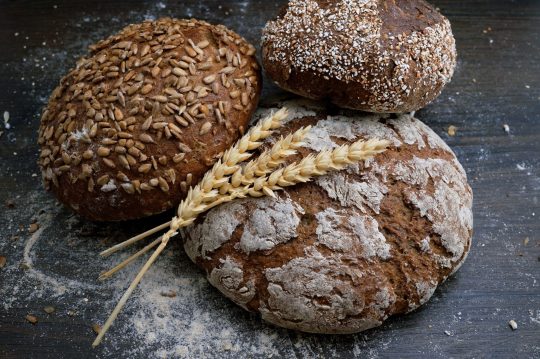
Gluten is a protein in grains like wheat, barley, and rye. It is essential to help knead the dough, provide elasticity, and allow it to rise when baking bread. Most commonly consumed grains contain gluten, and most people eat this protein all their lives without any problems.
However, some people may develop gluten sensitivity due to certain diseases. For them, it is best to consume gluten-free grains to avoid reactions like bloating, diarrhea, and stomach cramps. Also, regular gluten consumption may be harmful to health for everyone in the long run. In this article, we have listed some gluten-free grain options if you want grains with low gluten content or gluten-free grains.
What are the Harmful Effects of Consuming Gluten Regularly?
- Foods Containing Gluten – All commonly consumed grains like wheat, barley, and rye contain high quantities of gluten. Although whole wheat is considered healthy, it has been genetically modified to increase gluten, increase bread or roti calories, and reduce nutrition. It has helped mass-produce wheat and bread products, but in turn, it has made whole wheat a harmful, high-gluten food. Other foods that contain gluten are –
- Bulgar
- Wheat Grass
- Couscous
- Sausages
- Graham flour
- Ice Cream
- Spelt
- Roasted Nuts
- Wheat
- French Fries
- Wheat germ
- Barley
- Rye
- Health Complications and Diseases Due to Gluten – Gluten has various harmful effects on the human body. Our bodies produce an enzyme known as protease to digest proteins like gluten. However, consuming gluten in high quantities may remain undigested in your intestine for a long time. This build-up of undigested gluten may trigger an autoimmune response, making your body sensitive to gluten. Such a reaction is known as the celiac disease. Celiac disease may permanently damage the small intestine if untreated.
Those who do not have gluten sensitivity may also experience discomfort due to regular gluten consumption. Problems like bloating, diarrhea, headaches, or skin rashes are common among those who eat packaged foods daily.
- Who Should Avoid Gluten – Experts advise that everyone should limit their consumption of gluten-rich foods. However, those with health problems like celiac disease, gluten sensitivity, wheat allergy, or gluten ataxia should be particularly careful about the grains they eat.
Choose From the Following Gluten-Free Grains
- Oats – Oats are a popular alternative to gluten-rich grains. The ease of cooking oats is making them a household staple worldwide.
- Nutritional Content: Oats are rich in easy-to-digest proteins and healthy fats and contain less starch than other grains. It is also high in fiber, magnesium, zinc, selenium, and Vitamin B1. The beta-glucan in oats helps reduce blood sugar and improve insulin levels.
- Health Benefits: Consuming oats or oat bran for some time helps reduce LDL cholesterol and total plasma cholesterol in the human body. Oats are a good choice of grain for those with celiac disease or gluten intolerance.
- Usage: Enjoy a comforting bowl of oatmeal, or add oats to pancakes, granola bars, or parfaits for a healthy diet.
- Buckwheat – Buckwheat or kuttu ka atta is a nutritious option for gluten-free grains.
- Nutritional Content: Eating one cup of buckwheat grains can give you 5 grams of fiber, 6 grams of protein, plenty of antioxidants, and other nutrients like magnesium, copper, and manganese.
- Health Benefits: Usually, those who have high blood pressure, high cholesterol, and high blood sugar are advised to include buckwheat flour in their daily diet. Buckwheat helps reduce LDL cholesterol in the bloodstream and has anticancer and anti-inflammatory properties.
- Usage: Use buckwheat flour to make delicious pancakes, soba noodles, or fried treats.
- Millets – A humble but healthy option for people of all ages. Some of the most popular millets include jowar, bajra, and ragi.
- Nutritional Content: Millets are full of anti-toxins and valuable nutrients. They are rich in niacin, essential for skin health, vitamin A, and good carbohydrates.
- Health Benefits: Millets are ideal for age-onset degenerative diseases. It helps reduce the risk of coronary heart disease, protects from diabetes, and lowers cancer risk. Millets are non-acid forming and, therefore, much easier to digest for everyone.
- Usage: Bajra roti is a staple in many parts of India. You can also use millet to make fermented foods such as idli, dosa, dhokla, and uthappam. It can also be eaten as porridge with a healthy sweetener.
- Amaranth – Amaranth has a long history of being a staple grain for many large civilizations worldwide.
- Nutritional Content: Eating amaranth in one meal per day can supply your body with several essential nutrients like iron, magnesium, phosphorus, and manganese. It is also rich in protein and good cholesterol.
- Health Benefits: Research has shown amaranth contains compounds that prevent inflammation by blocking the neural pathways that trigger allergic reactions. As a fiber-rich food, amaranth is recommended to improve gut health and treat gluten intolerance.
- Usage: Use popped amaranth as a component in ladoos, chikkis, and sweetmeats. You can also use it to bake breads, cakes, and cookies.
- Gluten-Free Pulses – Pulses or legumes like chickpeas, black beans, pinto beans, and kidney beans are great substitutes for gluten-rich grains in your daily diet.
- Nutritional Content: Pulses are rich in proteins, essential vitamins including A and B, and several minerals.
- Health Benefits: Pulses are easy to digest and supply your body with essential proteins without harming your digestive system.
- Usage: Legumes and pulses should always be eaten soaked, sprouted, or pressure-cooked. Be mindful to break down the phytic acid in the pulses before consuming.
- Quinoa – Quinoa is increasingly gaining popularity as a gluten-free grain option among the modern population.
- Nutritional Content – Quinoa has many antioxidants, proteins, and amino acids. It also contains minerals like manganese, magnesium, and phosphorus.
- Health Benefits – Quinoa gained most of its popularity due to its help in weight maintenance. However, it is also effective for those with metabolic, cardiovascular, and gastrointestinal diseases.
- Usage – Quinoa is an excellent substitute for rice in dishes like pilaf, risotto, and paella. Add some quinoa to give your salads more substance and protein.
Following a gluten-free diet can be challenging, primarily if you have grown up eating wheat, barley, or other common grains. However, gluten-free grains are an essential switchover for those with celiac disease. They can help reduce their digestive discomfort, improve nutrition in their daily diet and help them eat a wholesome meal. If you wish to try a gluten-free diet, consult your dietician about a diet plan. Include grains like bajra, jowar, quinoa, and oats in your daily meals to reduce gluten consumption.
Following a gluten-free diet plan can help regulate your blood pressure, blood sugar, and cholesterol. You can not only avoid lifestyle diseases like diabetes and hypertension but also prevent the development of cancer and age-onset degenerative diseases like Alzheimer's and Parkinson's in the long run.
Photo by Wesual Click on Unsplash
Read the full article
0 notes
Text
Last week and this week's ⛽
Aiming to up my protein - training harder these days and want to optimise my progress and nutrition is a big factor
Cheesy 4 egg omelette with a side of baked beans and peas
Post workout Jordans nuts, Tamir's homemade protein granola, kefir, full fat yoghurt, green tea, 🍓🫐 🍌 protein smoothie
Chicken and Pak choi with homemade hummus wraps with a side of bulgar wheat, quinoa and roasted vegetables
Burger and chips whilst watching @noakirel come 3rd at the Eurovision song contest
Air fried salmon fillets with Pak choi (I bought a lot) with crushed Cashew nuts on the salmon and crushed walnuts on the Pak choi (sneak in that protein)
Pre workout coffee from @caffenero frappé latte 👌🏼
Cod (or haddock 🤷🏻♂️) with lentil pasta and broccoli 🥦
Chicken sandwich... Hack - buy sliced cooked chicken and add to make the chicken sandwich how it should look like 💪🏼
Egg fried rice with peas, sweetcorn and pak choi
Chopped tomatoes, beans, chicken, spinach, Pak choi (finally finished it all), peas with all sorts of spices and herbs (tumeric, paprika, cayenne pepper, sea salt, oregano, basil, dill)
If you've read this all I'm impressed 😁!
instagram
0 notes
Text
Iran and Georgia
INTRODUCTION
This week, I will be learning…
Method: frying, grilling, roasting, salad dressing
Menu:
Steamed Rice pg. 630 Persian Flatbread pg 636 Tahchin Morgh (Rice Stuffed with Chicken) Mirza Ghasemi (Eggplant Dip) Fesenjoon (pomegranate & walnut chicken stew) pg 627 kabab Koobideh (ground beef)
Sustainability Topic: water
Prior Knowledge
We have made some kebabs before. I am not sure what Iranian or Georgian food I have had before. The rice technique seems appealing. I think the shape always adds a great look to rice.
Learning Objectives
This week, we will Introduce the rich and varied histories of Iran and Georgia, their diverse geographies, cultural influences, and climates. Introduce the culinary culture, regions, and dining etiquette in Iran and Georgia. Discuss the importance of religion and the Silk Road on both cuisines. Discuss the importance of the supra and tamada on dining etiquette in Georgia. Identify the foods, flavor foundations, seasoning devices, and favored cooking techniques. Teach the techniques and the marvelous, creative dishes of ancient Persia, Iran, and the Republic of Georgia.
RESEARCH
Method of Cooking
Fat: Olive oil, butter, clarified butter, vegetable oil, sheep tail fat, dehen (seasoned sheep tail fat)
Sweet: Sugar, honey, pomegranate molasses, grape molasses, carob molasses
Sour/alcohol: Lemon, orange, bitter orange, red or white wine vinegar, pomegranate syrup, sumac powder, yogurt, kishk (fermented and powdered yogurt and bulgur)
Salty: Salt, olives
Spicy-Hot: Red chili pepper flakes, white and black pepper
Spice: Aniseed, cumin, allspice, cinnamon, saffron, cardamom, bay leaves, nutmeg, cloves, mastic, mahlab (ground cherry kernels), za’atar (spice blend of thyme, sesame, and sumac), mastic, seven-spice blend
Aromatic Seasoning Vegetables: Onion, garlic, carrot, celery, green onions
Herbs, Seasonings, and condiments: Italian parsley, mint, cilantro, oregano, orange blossom and rose flower waters, rose petal jam
Other important Foods: Sesame seed, tahini (sesame paste), nuts (pine nuts, pistachios, almonds, walnuts), burghul (bulgar wheat), short-grain rice, freekeh (roasted green wheat), fillo pastry, chickpeas, lentils, fruit (apricots, cherries, quince, dates, figs), olives, grape leaves, cabbage, eggplant, zucchini, tomatoes, cucumbers, romaine, artichokes, okra, green beans, fish, meat (lamb, chicken, goat), pastirma or basturma (spice-rubbed, dry-cured beef)
Popular Dishes: Khobz arabi (flatbread) and khobz marquq (paper-thin flatbread), baklava, hummus (chickpea and tahini dip), baba ghanouji (eggplant dip), kibbeh (dish with lamb and bulgar), fattoush (salad with dried or toasted flatbread), labneh (strained yogurt), m’jaddarah (lentils, rice, and crisp-fried onion), tabbouleh (bulgar wheat salad), falafel (deep-fried chickpea balls), mezze (any dish served in small portions as appetizer), shawarma (shaved grilled meat)
Drinks: Ayran (yogurt drink), tea, Arabic and Turkish coffee, arak (anise-flavored liqueur), lemonade, beer, wine, jallab (drink made with ice, grape molasses, and nuts)
https://www.hungrypaprikas.com/ayran/
Origin and History
“Iran has long been an intersection of East and West, absorbing dark invasions, trade, disaster, conquests, migrations, and settlements. Over centuries, Persian, Byzantine, Frankish, Slavic (Balkan), Roman, Venetian, and Turkish foods and techniques, like paprika, lemons, tomatoes, bell peppers, and potatoes, influenced the continually evolving Iranian cuisine. “ (1)
Map of Cuisines
What influences the various areas being studied? For example, does the area have maritime influences, mountains, dry, Mediterranean climate, what is the weather like?
Prepare the following questions for class discussion:
Iran/Persia
What is the reason for the early sophistication of Persian Cuisine?
What other cultural influences shaped Persian-Iranian cuisine?
What was the Silk-Road?
Name two important Persian dishes?
Republic of Georgia
What cultures left their influences on Georgian cuisine?
Discuss the foods and herbs important to Georgian cuisine.
What is the premier soup of Georgia? What are its main ingredients?
In your research, bring one-two interesting findings from the area to share in class.
Dish Method Variations
Falafel: Bake or Broil: Brush the balls or pat- ties with olive oil and bake in preheated 400 degree F oven 20 minutes, then broil to brown them.
Sources
1) Discovering Global Cuisines
2)https://www.whiskaffair.com/sumac-onions-recipe/
RECIPES
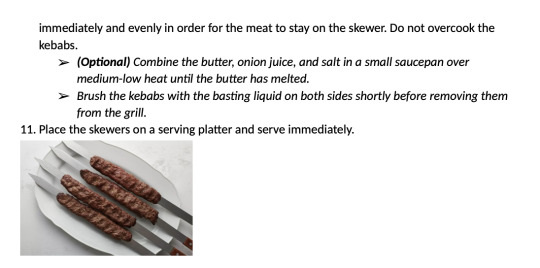


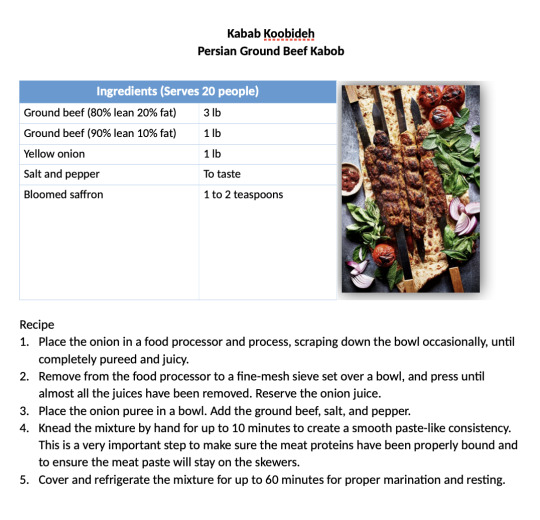
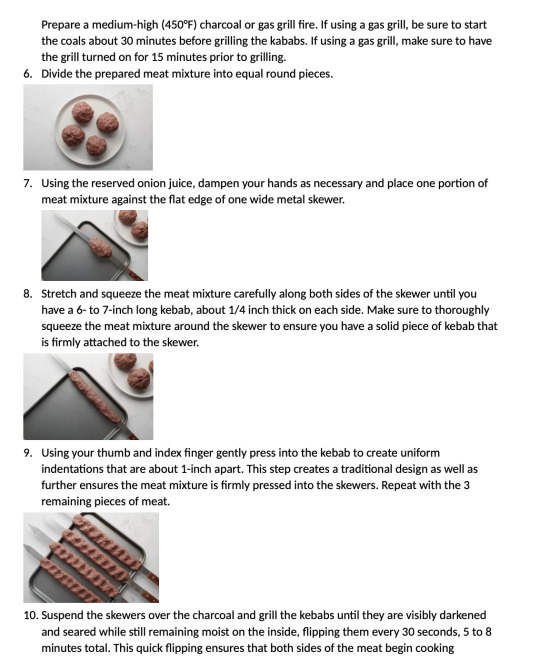
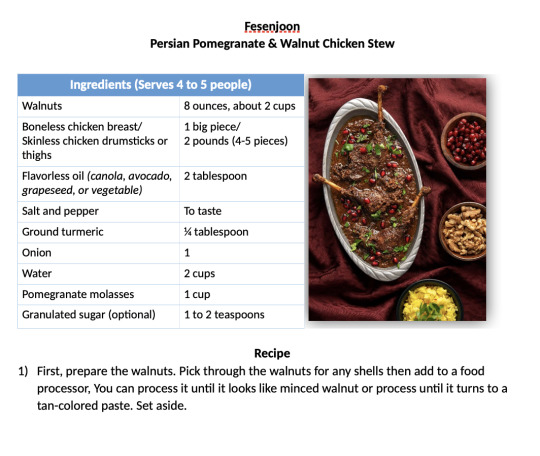
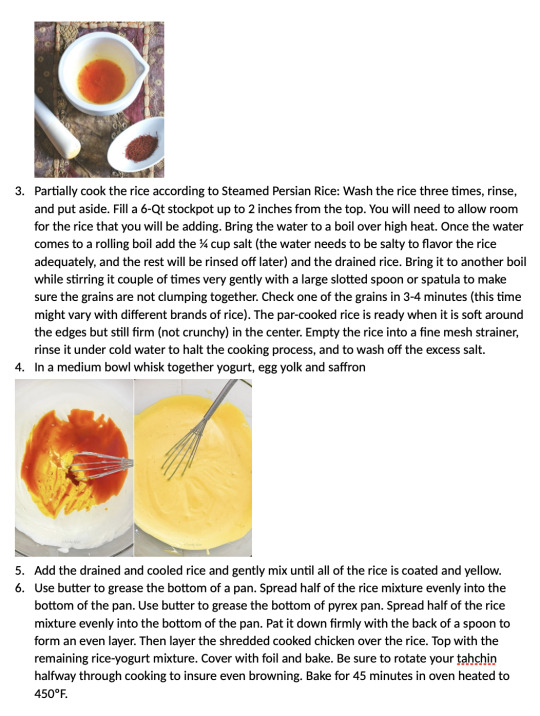
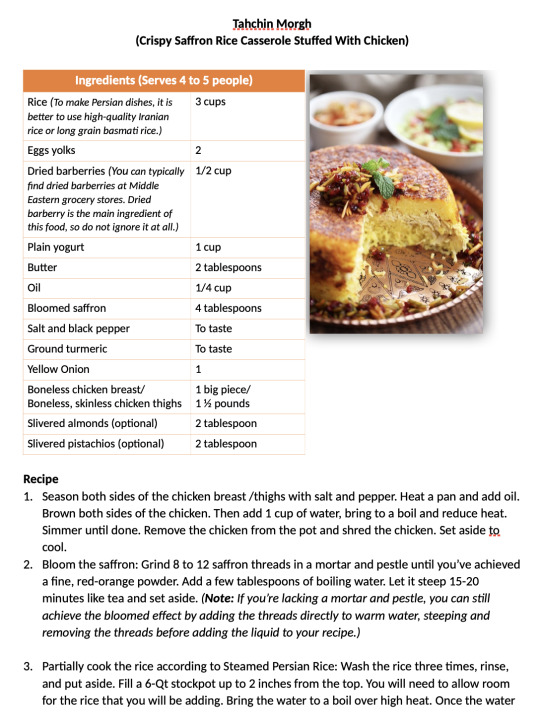
0 notes
Text
Today's diet
Breakfast
1. Sweet potato & Bulgar wheat
2. 2 hashbrown's
3. 2 eggs, spinach, and mushrooms
Lunch
1. Nature Valley Bar
Dinner
1. Water Bottle
0 notes
